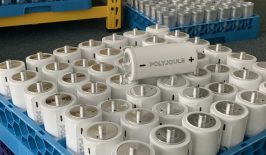Creating cheap, reliable and efficient renewable energy storage solutions will determine the success of our world’s future clean energy transition. Renewable sources come with many environmental benefits, but have the significant downside of not being able to generate electricity consistently over time. As a result, storage solutions are required to store power in times of surplus, to be released in times of energy deficit.
Fundamentally, the challenge of energy storage revolves around turning electrical energy into another form, which then be reverted back into electrical power. Currently many different methods of energy storage are being used, but the most common is the use of large lithium-ion batteries. Lithium-ion does come with some distinct advantages, it is relatively efficient in terms of charging and discharging and can be easily scaled and deployed in a variety of environments. However, lithium-ion batteries remain expensive, come with safety concerns and perform poorly in different temperatures. As a result, researchers have been exploring new ways of developing batteries.
One Canadian-based venture, e-Zinc, has been looking at ways of using metal within a battery to store renewable power. As their name suggests, they have developed a zinc-based battery which, they claim, does away with many of the disadvantages of lithium-ion cells.
Their battery consists of three major parts, a charging section, storage section and discharging section. Instead of using metal fixed onto electrodes, as per a traditional lithium-ion battery, e-Zinc’s model uses a novel detachable metal system. Within the charging section is a liquid electrolyte including dissolved zinc. When power passes through the charging section, the dissolved zinc reforms on the electrodes in small clusters. When these are large enough, these detach from the electrodes and fall into the central storage section where they can be kept for later use.
When power is then needed from the battery, the zinc is redissolved into the electrolyte solution, releasing the stored power back into the grid. The zinc solution can then be moved back into the charging section for the next charging cycle. By using this method, the metal itself is being used as the energy carrier and storage medium.
E-Zinc claims their method has some distinct advantages over lithium-ion batteries. Firstly, their system uses cheaper raw materials, with zinc being a common, abundant and affordable raw resource. There are also no inherent fire risks within the e-Zinc battery, and the water-based electrolyte is non-flammable. The battery can also operate within a wide range of temperatures, and does not lose any of its charging efficiency over time. Finally, the zinc battery can also be easily scaled and modified to fit different needs or requirements.

The 1.5 degree target is unattainable without a real transformation of our energy system. But how can it succeed? What are the energy sources of the future? What digital solutions are ready and where are innovations needed? And how can the transformation be driven forward?
The RESET Greenbook “Energy Transition – The Future is Networked” presents digital, innovative solutions and sheds light on the background.
Currently, e-Zinc is developing a series of trial projects with major partners, including Toyota Tsusho Canada Inc and California Energy Commission. Included in these projects is a 1.3 million USD field demonstration in which e-Zinc batteries will be used to store renewable energy generated from wind power.
However, zinc is not the only element looking to dethrone lithium in the renewable energy battery market. Previously we have discussed batteries which use sodium as their energy carrier, or more recently compressed hydrogen. Outside of rechargeable batteries, there are also many other ways to store renewable energy, including pumped hydro-storage, lifting and dropping weights, or superheating rocks and stones.
It is also worth noting, that although zinc is more abundant and cheaper than lithium, its extraction and mining does come with environmental concerns. Areas around zinc mines often see increased levels of water and soil pollution, reducing in lower levels of biomass and the contamination of agricultural areas.









